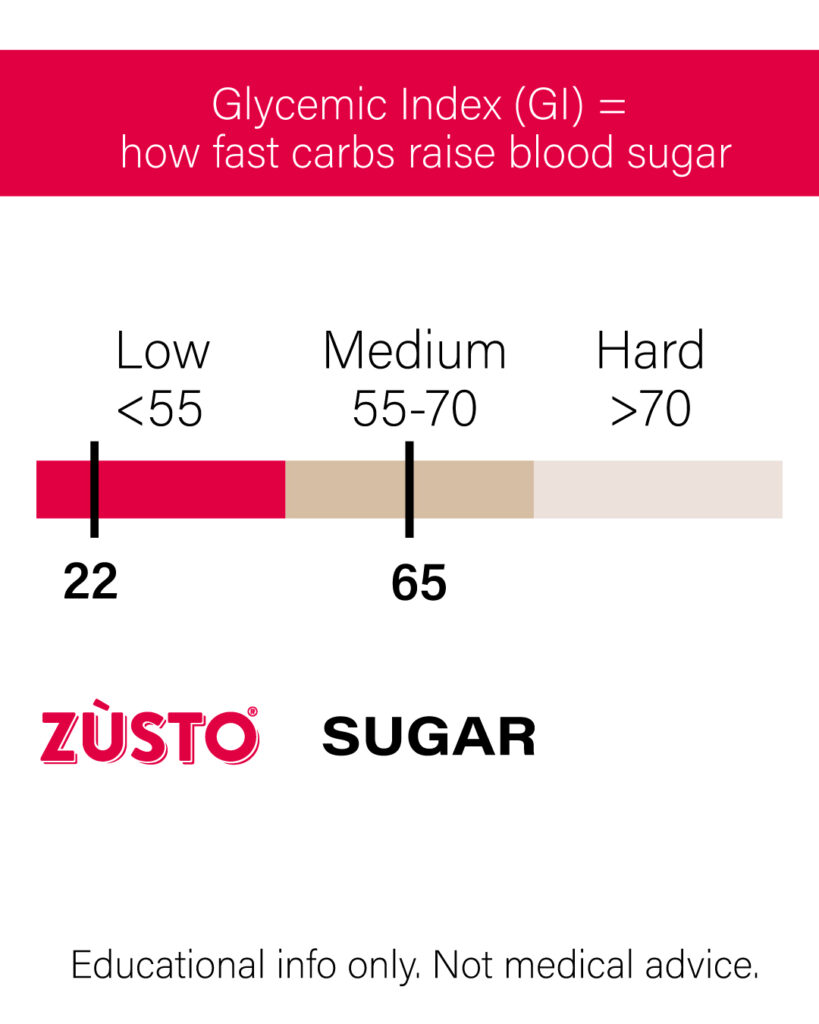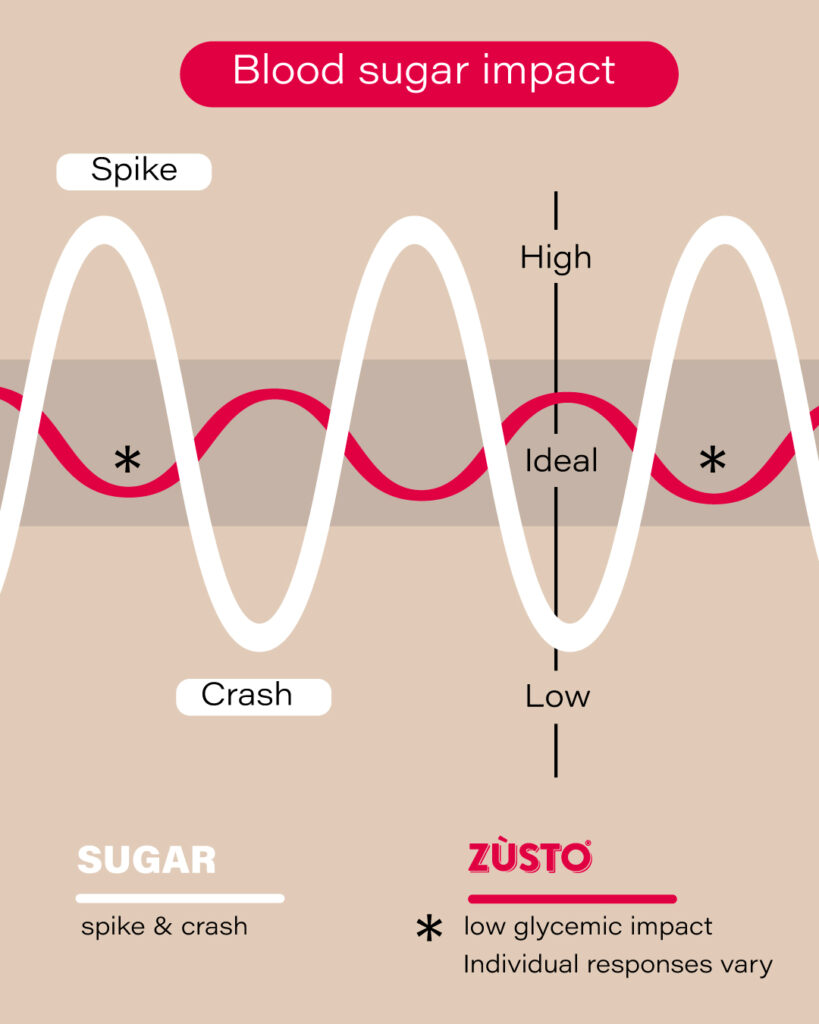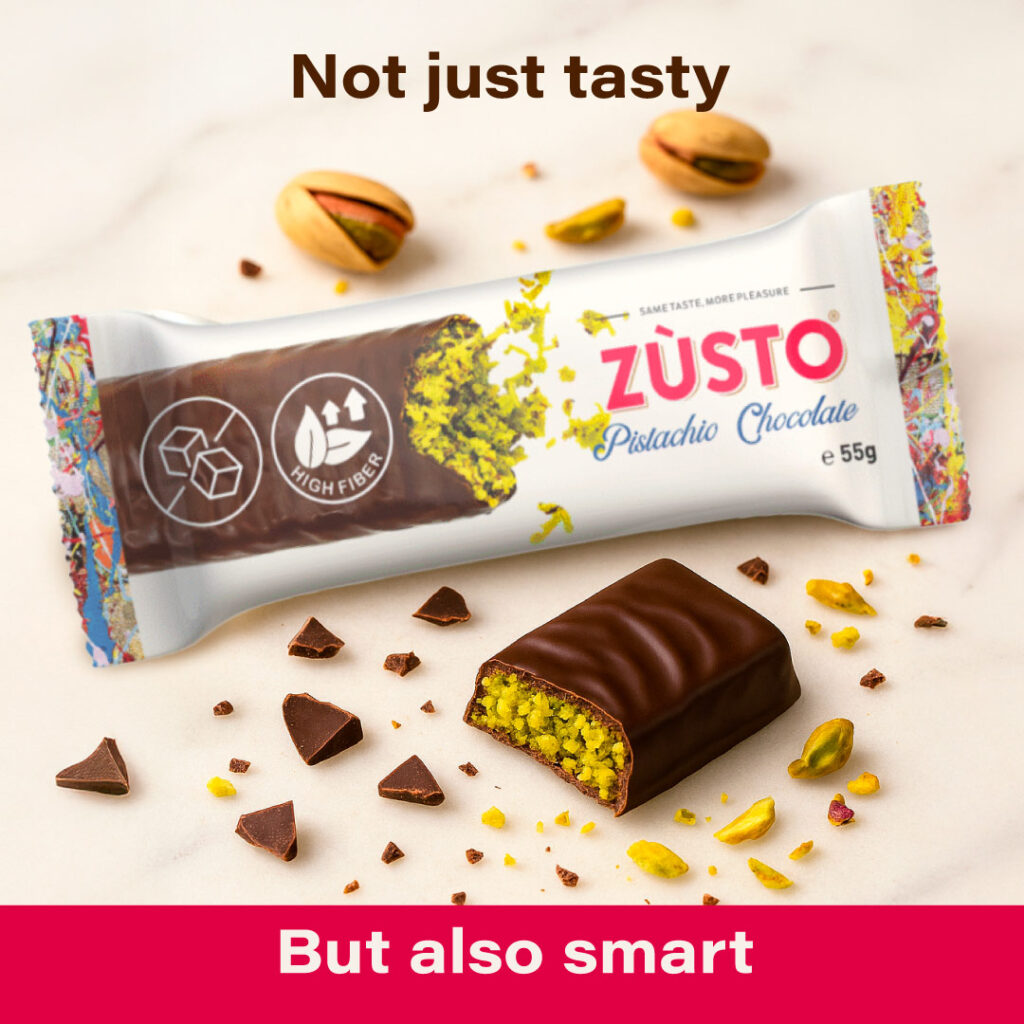- info@zusto.com
- Free shipment from €50 (Only in Belgium)
- Secure payment
- 100% happiness guarantee

GI vs GL: Choose Sweetness That Matches Real-Life Portions
Numbers that actually matter day to day You’ve seen “low GI” on labels, but your real‑life question is simpler: how will this sweet thing affect me when I eat it the way I actually do? That’s where glycemic load (GL) joins glycemic index (GI). GI measures speed; GL captures the total effect based on portion size. This guide demystifies GI vs GL, shows how mixed meals reshape the response, and translates it all into practical Zùsto use cases—so you can choose sweetness that supports steady energy.
What GI is—and what it isn’t
- GI (glycemic index) measures how quickly a fixed amount of carbohydrate from a food raises blood sugar compared to a reference (glucose or white bread).
- Low GI usually means a slower, flatter blood sugar rise.
- Limits: GI is tested in isolation, not with your latte, yogurt, or dinner. It also ignores portion size.
What GL adds that GI misses
- GL (glycemic load) = GI x grams of digestible carbs in your portion ÷ 100.
- Translation: GL weights the speed (GI) by how much carbohydrate you actually consume.
- Why this matters: A low‑GI food eaten in huge portions can still deliver a high GL. Conversely, a small portion of a higher‑GI food may have a modest GL.
The mixed‑meal effect: Real food isn’t eaten alone
- Protein and fats slow gastric emptying, often flattening post‑meal glucose curves.
- Fiber reduces the rate of carbohydrate absorption and can improve satiety.
- Practical takeaway: Evaluate sweetness within a meal context. Coffee with milk and a fiber‑forward sweetener behaves differently than sugar water.
How Zùsto fits (and why low‑GI, fiber‑forward helps)
- Fiber‑forward design: Choosing a sweetener with functional fiber adds bulk without the fast sugars, helping smooth the curve.
- Low‑GI ethos: Aims to deliver sweetness with a gentler response than traditional sugar.
- 1:1 practicality: If it measures like sugar but behaves more steadily, you can swap it into your routine without re‑learning your kitchen.

Everyday comparisons: GI vs GL in the real world These simplified examples highlight how portion and pairing change the picture. Numbers below are conceptual to explain the principle—your own response can vary.
- Coffee sweetening
- Sugar spoonful: Higher GI ingredient; modest portion might still feel “spiky” for sensitive individuals, especially on an empty stomach.
- Zùsto spoonful: Low‑GI, fiber‑forward profile; similar sweetness with less digestible sugar, contributing to lower GL in context.
- Yogurt bowl
- Sugar + fruit: Higher total digestible carbs raise GL, even if the yogurt’s protein helps.
- Zùsto + fruit: Protein from yogurt + fiber from sweetener and fruit generally leads to a gentler curve, often with better satiety.
- Baking
- Sugar cake slice: High GI and higher grams of digestible carbs per serving push GL up.
- Zùsto‑sweetened cake slice: Designed to reduce digestible carbs and overall calorie load; fiber base helps mitigate GL relative to the sugar version.
Serving reality: The 5 questions that keep GL in check
- What’s my actual portion? Not the label’s teaspoon—your real spoon.
- Is this with protein/fat/fiber? If yes, expect a flatter curve.
- Is the sweetness the main carb source? If so, smart swaps have big impact.
- Is this a snack or part of a meal? Snacks on an empty stomach can spike faster.
- Do I need full sweetness? Many people acclimate to using less over time.
A quick label scan that respects GI and GL
- Ingredients: Prefer fiber‑forward bases; avoid high‑GI fillers (e.g., maltodextrin) high in the list.
- Per 100 g view: Lets you compare calories, total carbs, and fiber across brands fairly.
- Digestible carbs: Total carbs minus fiber and certain polyols (context matters) give you a rough “GL potential.”
- Claims alignment: “Low GI,” “1:1 replacement,” and “diabetic‑friendly” should match the panel data and your portion reality.
Practical Zùsto use cases
- Morning latte: Sweeten with Zùsto and add a sprinkle of cinnamon. Protein in milk + fiber‑forward sweetener = friendlier GL than sugar‑syrup drinks.
- Yogurt parfait: Stir Zùsto into Greek yogurt; add berries and a light crunch. Protein + fiber supports satiety and steadier energy.
- Iced coffee or cold brew: Sweeten with Zùsto, then add a splash of milk. Shaking with ice helps distribute sweetness evenly without overshooting your portion.
- Simple sauces and glazes: Balance acidity in tomato sauces or citrus glazes with Zùsto for flavor control without the sugar surge.
- Occasional dessert: A Zùsto‑sweetened brownie square post‑meal (not on an empty stomach) typically plays nicer with your energy curve.
GI vs GL myths—cleared up
- “Low GI means I can eat unlimited amounts.” No. GL rises with portion size.
- “Net carbs tell me everything.” Not always. Fiber types and polyols behave differently; your response may vary.
- “GI is the same for all foods of a type.” GI depends on the exact formulation and testing. Blends, fiber content, and processing matter.
- “Mixed meals don’t change much.” They do. Protein, fat, and fiber can significantly alter the curve.
Coaches’ corner: Teaching GI vs GL to clients
- Focus on swaps within routines, not total overhauls.
- Track “sweet moments” across the day and replace the 1–2 biggest drivers first.
- Encourage “post‑meal” treats instead of “pre‑meal” or “empty stomach” treats.
- Use portion visual anchors: teaspoon first, then taste, then adjust.

If you monitor glucose, test your own response
- Try one change at a time (e.g., coffee sweetener) for 3–7 days.
- Check 60–120 minutes post‑intake to see your typical pattern.
- Note satiety and cravings, not just numbers; GL touches appetite, too.
- Adjust portion and timing before switching products—often that’s all it takes.
A simple decision guide (GI and GL together)
- Step 1: Is sweetness the main carb here?
- Yes → Choose a fiber‑forward, low‑GI sweetener and mind your portion.
- No → Keep portion moderate; pair with protein/fiber to lower GL.
- Step 2: When am I having it?
- Empty stomach → Reduce portion or pair with protein/fat/fiber.
- With/after a meal → You have more leeway; GL typically improves.
- Step 3: How sweet do I need it?
- Start lower; palates adapt. Many people enjoy 10–30% less after a week.
- Step 4: Did I check the label?
- Fiber type up front, digestible carbs reasonable, claims aligned.
Zùsto in your plan: Where it shines
- Coffee and tea: Clean sweetness, easy to dial in, fewer “spikes and slumps.”
- Breakfast bowls: Supports a balanced macro mix that helps tame mid‑morning cravings.
- Baking: 1:1 usability means favorite treats with a smarter profile.
- Everyday sauces: Flavor control without leaning on fast sugars.
Key takeaways
- GI measures speed; GL captures total impact. You need both to match real‑life portions.
- Mixed meals, fiber, protein, and fat reshape your glucose curve—for the better.
- A fiber‑forward, low‑GI sweetener like Zùsto fits naturally into routines, helping reduce GL without sacrificing taste.
- Portion and timing are your levers. Use them first; they’re free and powerful.
Important note This article is educational and not medical advice. If you manage diabetes or metabolic conditions, personalize your approach with your healthcare provider and consider testing your response to new sweeteners and portions.








